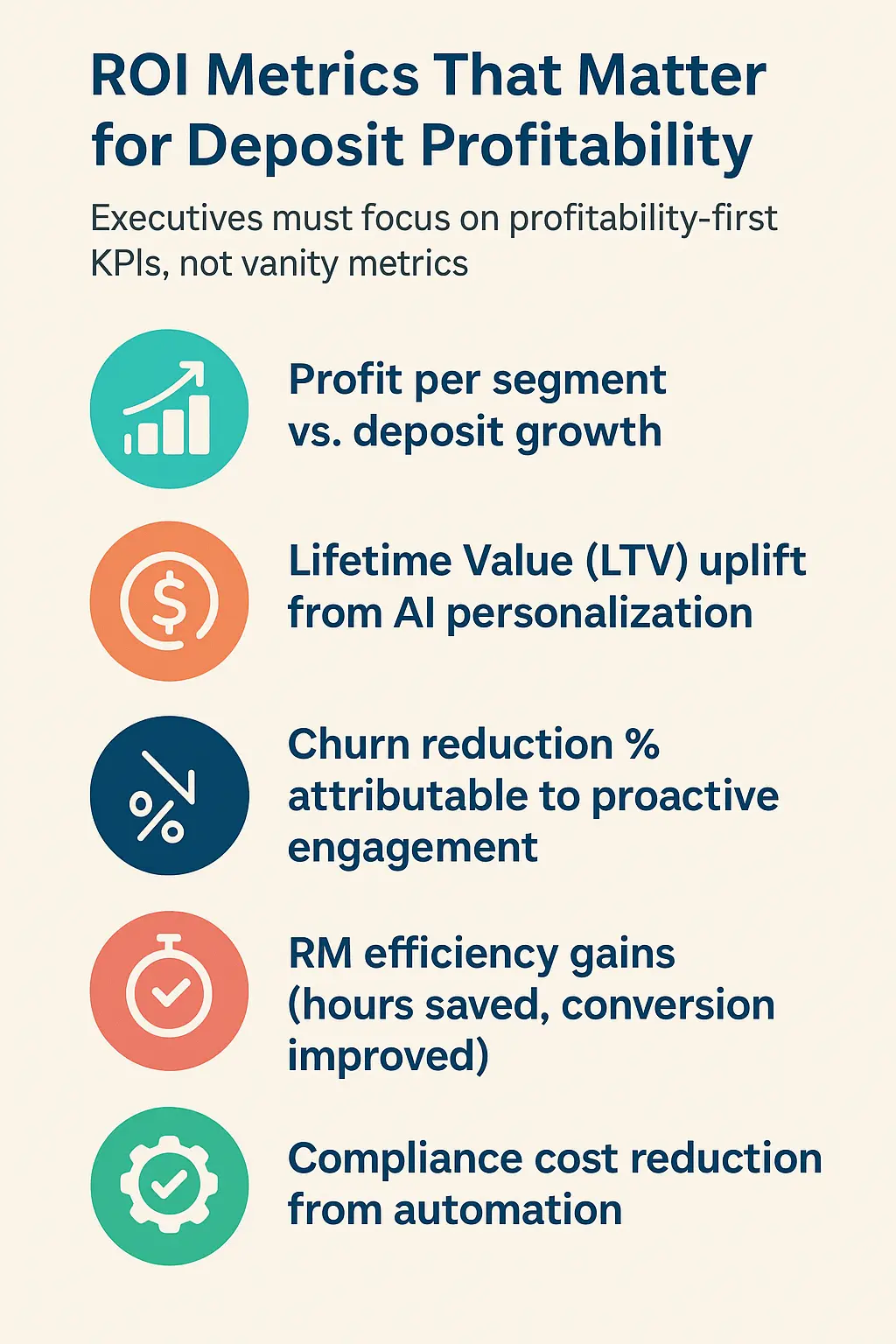For decades, banking leaders measured success by deposit growth. Bigger balance sheets were equated with stronger performance. But in today’s environment – defined by margin compression, regulatory scrutiny, and shifting customer expectations – deposit volume has become a vanity metric.
TL;DR
- Deposit volume ≠ profitability: Growing balances without margin clarity risks eroding long-term shareholder value.
- Profitability signals matter: They highlight which customers, journeys, and behaviors drive sustainable returns.
- VARTA advantage: VARTASense transforms predictions into actions – surfacing signals, triggering interventions, and proving ROI.
- Boardroom-ready outcomes: Banks adopting VARTA’s profitability-first approach can increase profitability in banking by 20–30% while reducing churn and compliance risks.
Introduction: The Strategic Shift From Volume to Profitability
The true competitive advantage now lies in profitability signals: the hidden patterns that reveal which customers, products, and journeys contribute to sustainable growth.
Yet, most banks struggle to detect, interpret, or act on these signals. Data is siloed, AI predictions remain trapped in dashboards, and customer journeys often break because no single system owns both the insight and the follow-through.
Enter VARTA. The only growth-as-a-service platform built for BFSI that turns predictions into outcomes. Instead of merely forecasting churn or upsell potential, it ensures interventions actually happen, across channels, with measurable ROI.
What Are Profitability Signals in Banking – and Why Do They Matter?
In banking, not all deposits are created equal. Some customers may appear valuable on paper because of their large balances, yet contribute little to long-term profitability. Others, with smaller deposits, generate far more sustainable value through cross-sell potential, digital adoption, and loyalty-driven behaviors.
This is where profitability signals come into play. They are data-driven indicators that reveal:
- Which deposits and customer cohorts generate risk-adjusted returns
- Where lifetime value (LTV) outweighs short-term volume
- Which journeys or interactions signal future cross-sell and upsell opportunities
Unlike traditional KPIs, profitability signals combine financial outcomes with behavioral, digital, and servicing insights to provide a 360° view of true customer value.
Why Profitability Signals Matter for C-Suite Leaders
Executives today face unprecedented margin pressure, customer churn, and compliance costs. Focusing solely on volume is not only misleading but strategically dangerous.
Here’s why:
- Volume ≠ Loyalty
A depositor with a high balance may switch banks overnight for a marginally better rate. Without profitability signals, banks may misallocate resources chasing relationships that lack staying power. - Cross-Sell Blind Spots
Not all segments are equally profitable for upsell. For example, offering a low-margin product to a high-cost segment may cannibalize existing revenue. Profitability signals help identify where upselling increases overall LTV instead of diluting margins. - Hidden Servicing Costs
Dormant accounts, manual servicing requests, and low digital adoption silently drain profitability. Signals expose these inefficiencies so leaders can redirect RM effort and digital nudges toward higher-value opportunities.
Strategic Impact
- Profitability signals tie directly to ROE uplift and shareholder value.
- They offer clarity on which journeys to prioritize for engagement, personalization, and investment.
- They highlight where AI and automation can drive down costs while boosting growth.
In short, without visibility into profitability signals, banks risk scaling unprofitable relationships, overinvesting in low-value cohorts, and missing hidden high-value opportunities.
Boardroom-Proven Metrics to Increase Profitability in Banking
One of the biggest mistakes banks make is measuring growth by volume, not value. Traditional metrics like total deposits or new accounts opened are vanity indicators – they look good in quarterly reports but say little about sustainable profitability.
Bank leaders must instead track profitability-first KPIs, which reveal the true financial health of deposit portfolios. These signals, when surfaced and acted on by AI platforms like VARTA, directly connect customer engagement to measurable bottom-line outcomes.

1. Profit Per Segment vs Deposit Growth
- Why it matters: Not all deposits are created equal. A ₹100 crore inflow from a price-sensitive corporate may be less valuable than ₹10 crore distributed across digitally engaged, cross-sell-friendly customers.
- How VARTA helps: By segmenting customers into profitability tiers, VARTA pinpoints which segments generate net contribution after factoring in acquisition, servicing, and churn costs.
Executive takeaway: Move beyond “deposit size” and prioritize deposit quality – a critical shift in capital allocation.
2. Lifetime Value (LTV) Uplift from AI Personalization
- Why it matters: According to Accenture, banks that personalize at scale see a 10-15% revenue lift. LTV isn’t static; it grows with deeper engagement.
- How VARTA helps: Through hyper-personalized nudges and micro-segmentation, VARTASense predicts which customers are likely to expand product holdings and nudges them into profitable journeys.
Executive takeaway: LTV isn’t about acquisition – it’s about compounding profitability over time.
3. Churn Reduction % Attributable to Proactive Engagement
- Why it matters: Churn silently destroys profitability. Retaining an existing customer is 5-7x cheaper than acquiring a new one.
- How VARTA helps: Predictive churn models detect at-risk accounts, triggering proactive retention campaigns (SMS + RM call + personalized offer).
Executive takeaway: Even a 5% reduction in churn can translate to 25–30% profit uplift – making churn prevention one of the highest-ROI initiatives.
4. RM Efficiency Gains (Hours Saved, Conversion Improved)
- Why it matters: Relationship Managers are high-value resources. Time spent chasing low-value accounts is time wasted.
- How VARTA helps: VARTA provides AI-curated RM nudges – clear, actionable prompts like “Call Client X – profitable but churn risk”. This improves both productivity and conversion rates.
Executive takeaway: With 20-30% RM productivity gains, leaders can reallocate RM capacity to high-margin accounts, directly boosting profitability.
5. Compliance Cost Reduction from Automation
- Why it matters: Compliance is unavoidable, but it’s also one of the heaviest cost centers in banking. Non-compliance adds reputational and financial risk.
- How VARTA helps: Its explainable AI and compliance-aware routing reduce manual oversight and flag exceptions automatically.
Executive takeaway: Automating compliance not only cuts 20-30% of compliance costs but also enhances boardroom trust in AI-driven profitability strategies.
By reframing ROI around profitability-first metrics, banks can connect every intervention – retention campaign, cross-sell effort, RM call, compliance process – to board-level financial outcomes. This isn’t about activity; it’s about profitability accountability.
Real-World Scenarios of Profitability Signals in Action
Profitability signals are not abstract concepts – they create measurable business impact when applied with the right intelligence layer. Here’s how banks in corporate banking, retail banking, and wealth management have leveraged VARTASense to turn data into outcomes.
Corporate Banking: Migrating Low-Margin Depositors to Fee-Based Services
The Pain Point: Corporate banks often celebrate large deposit inflows, but many of these clients generate low net interest margins. High servicing costs and pricing sensitivity dilute profitability. The C-suite question becomes: “How can we increase profitability in banking without alienating deposit-heavy but low-margin clients?”
The VARTA Intervention:
- Signal Detection: VARTASense flagged segments with high deposit balances but consistently low contribution to net income.
- Action Orchestration: Instead of chasing more deposits, the system triggered cross-sell campaigns toward fee-based treasury, liquidity, and cash management services.
- Human-in-the-Loop: Relationship Managers received AI-curated nudges with scripts for repositioning discussions.
The Outcome: Within one fiscal year, the bank realized a 15% revenue lift – not by growing deposits, but by redirecting clients into profitable services that aligned with their needs while enhancing relationship depth.
Retail Banking: Reducing Dormant Account Churn with Always-On Engagement
The Pain Point: Dormancy is one of retail banking’s biggest hidden drains. Accounts that once appeared valuable become inactive, locking capital while eroding profitability. Executives frequently ask: “Can AI reduce churn and re-activate value without ballooning acquisition costs?”
The VARTA Intervention:
- Micro-Signal Detection: VARTASense identified early dormancy indicators (e.g., logins without transactions, salary credits without spend).
- Always-On Journeys: Automated nudges – SMS, WhatsApp, in-app notifications—encouraged small transactions, savings activations, or card usage.
- Personalized Messaging: GenAI tailored tone and CTA by customer persona, ensuring contextual resonance.
The Outcome: Dormant churn reduced by 22%, while re-activated accounts demonstrated higher cross-sell readiness. Instead of spending heavily on new acquisitions, the bank increased its profitability in banking by reviving and monetizing existing customer relationships.
Wealth Management: Portfolio Optimization Driving Higher Wallet Share
The Pain Point: Wealth managers struggle to allocate advisor time effectively. Advisors often focus on relationship maintenance instead of growth. Leadership often questions: “How can we help advisors focus on high-value opportunities that grow wallet share?”
The VARTA Intervention:
- Profitability Signal Mapping: VARTASense analyzed portfolios to identify clients under-invested relative to income, risk appetite, and peer benchmarks.
- Advisor Copilot: RMs received AI-powered recommendations: next-best offers, product suitability, and even call scripts.
- Journey Rewriting: If a customer hesitated, VARTA automatically shifted the engagement to educational nudges, ensuring the journey didn’t “drop off.”
The Outcome: Over 18 months, optimized advisor time allocation and targeted interventions resulted in a 12% increase in wallet share. The bank didn’t just preserve relationships – it expanded profitability across its most valuable customer base.
The Strategic Lesson for C-Suite
Across these scenarios, the takeaway is clear:
- Deposit growth is not the goal – profitability growth is.
- VARTASense surfaces hidden signals that point executives toward high-return actions.
- Banks that embrace this shift are equipped to increase profitability in banking sustainably, balancing risk, compliance, and customer value.
Is a Profitability-First Strategy Aligned with Compliance & Risk?
Yes. Profitability-first banking is about risk-adjusted growth, not maximizing returns at all costs.
- Basel III alignment: Capital efficiency improves when deposits are managed for profitability, not volume.
- GDPR/RBI compliance: VARTASense ensures explainable AI, audit trails, and PII-safe analytics.
- Governance-ready outputs: Every intervention is measurable, transparent, and ROI-linked.
Conclusion
For decades, banking performance was measured in terms of size – bigger deposit books, more accounts, higher volumes. But today, that equation no longer holds. Deposit growth without profitability is unsustainable in an environment shaped by margin compression, customer mobility, and heightened regulatory oversight.
The future of banking is not about building bigger books – it’s about building smarter ones. Smarter in how relationships are nurtured, how margins are protected, and how growth aligns with regulatory and shareholder expectations.
For leaders tasked with safeguarding profitability and steering long-term transformation, the takeaway is clear: profitability-first banking is the only sustainable strategy.

 Centralized Engagement Hub
Centralized Engagement Hub Revenue Accelerator
Revenue Accelerator Dynamic Communications
Dynamic Communications Data Adapter & Integrations
Data Adapter & Integrations Interoperability
Interoperability
























 Banking
Banking
 Financial Services
Financial Services
 Utilities
Utilities
 Insurance
Insurance
 Healthcare
Healthcare
 Credit Unions
Credit Unions
 Telecom
Telecom
 Professional Services
Professional Services
 Consulting & Advisory
Consulting & Advisory
 Legacy Migration
Legacy Migration


 Insights
Insights
 Whitepapers
Whitepapers
 FAQs
FAQs
 Brochures
Brochures
 E-Books
E-Books
 CCM Glossary
CCM Glossary 
 Case Studies
Case Studies
 About Us
About Us
 Information Security
Information Security
 FCI Cares
FCI Cares
 Leadership
Leadership
 Careers
Careers
 Partner Program
Partner Program
 Current Openings
Current Openings



